Just in time for the April 2023 opening of Carnegie Museum of Natural History exhibit, So Many Bugs!, I popped into the entomology department at the museum for a fascinating peek at the insect haven and came home with not only a new understanding of insects, but a reason for learning more.
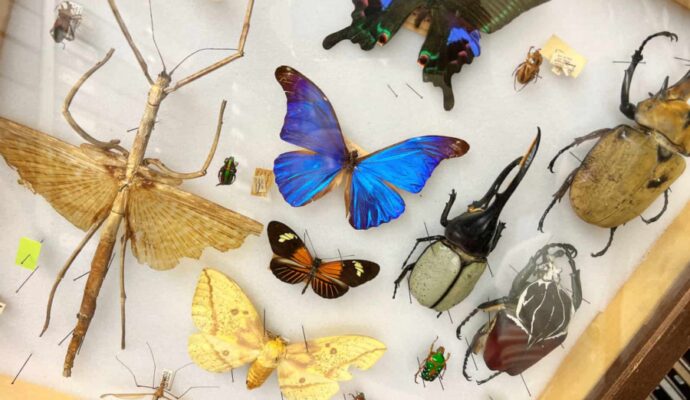
Carnegie Museum of Natural History Entomology
As a young girl, visiting the Carnegie Museum of Natural History (CMNH) was my go-to place to see in Pittsburgh, PA. Yes, instead of shopping for toys or clothes, I wanted to walk the halls and exhibits to spy the taxidermic animals, check out the astounding dinosaurs, and mosey through the Hall of Architecture. I also wanted to pop into the gift shop and buy small stones in plastic boxes to add to my already-large collection.
As for the Carnegie Museum of Natural History entomology department, it was always a slow walk past the clear glass windows that showcased row after row, and drawer after drawer, of insects. Mostly, the lights were very dim or not on at all, but once in a while I’d spy a scientist with one of the drawers open. That few seconds of curiosity always made me wonder what the rest of the space looked like.
Fast forward to 1991 when “The Silence of the Lambs” was a smash hit at the box office. Another curious resurgence about the department compliments of my favorite movie (yes, it still is after all of these years) was when I realized an important, but still kind of comical, scene in the film was filmed involving insects and board games. I knew that one day I’d have to see what makes the department tick – no pun intended.
Recently I was given not only the pleasure, but the honor, of checking out what the department looks like and how they keep each of its 16 million insects catalogued and noted. And if that wasn’t enough, I had the pleasure of speaking with the head of the department to learn why she’s living her best life surrounded by insects.
Carnegie Museum of Natural History Entomology: The Study of Wondrous Wow
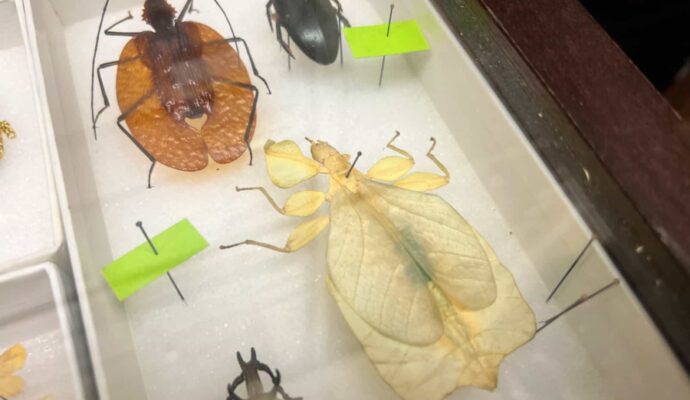
According to research, around 25 percent of people are terrified of bugs. The fear, officially called entomophobia, can be caused from a negative experience as either a child or later on in life.
For me, insects have never really given me the creeps. That’s not saying that I’d love to be surrounded by a bunch of live ones, but I feel they’re much more fascinating and beautiful than icky. And among insect-loving professionals from the museum, one of the first parts of my tour was in the “Wow” section. With several drawers literally labeled “Wow”, each is filled with both beautiful and giant insects that truly make visitors say the exclamation.
A Lesson in the Evolution of Iridescence
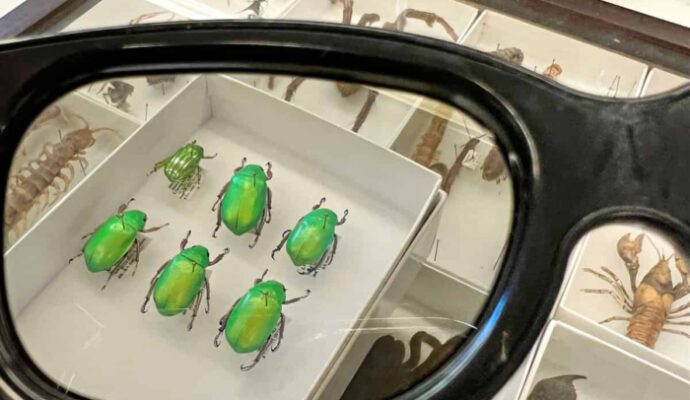
During my hour-long visit, I had the pleasure of learning about the evolution of one particular insect, a Chrysina Jewel scarab beetle. While looking at it with the naked eye it’s shiny, green exoskeleton (all insect exoskeletons are made from chiton which is tough and practically lasts forever) is brilliant and highly noticeable, especially when the sun catches it.
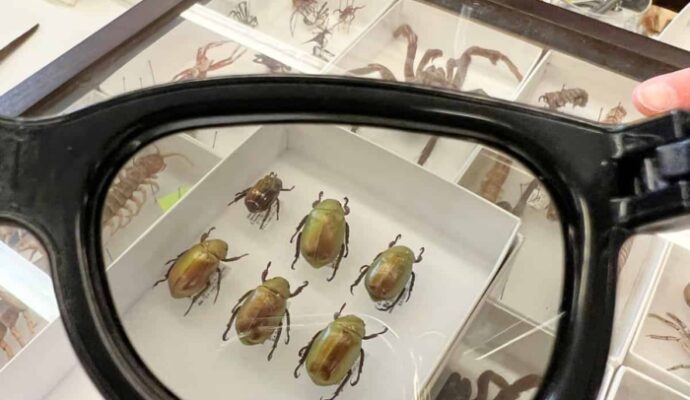
But grab a pair of polarized glasses and you’ll see something truly amazing: one lens makes the green even more vibrant while the other side looks dull and brown. This iridescence is from three-dimensional photonic crystals on the carapace is a protective evolution in that for insects with the color shift may be a form of camouflage and may hinder a prey attack.
Carnegie Museum of Natural History Entomology: Curating Inquisitiveness

This is undoubtedly compliments of having watched or read too many movies and books with museum curators, but they always seem to come off stuffy and entirely too intelligent for the normal person. But everything I just wrote is completely untrue for CMNH’s Ainsley Seago.
Curator for the Section of Invertebrate Zoology at the Carnegie Museum of Natural History, she earned her BS in entomology from Cornell University in 2003 and her PhD in entomology from U.C. Berkeley in 2008. And when speaking with her, she’s one of us.
If she sees visiting children curious about insects, she’ll pop out of the department with a box of polarized glasses so they can see the iridescent beauty for themselves. There’s zero stuffiness or pretension about her, making her a breath of fresh air in a closed department.
What I truly enjoyed about our conversation was learning about why she chose entomolgy as her profession. For her, the answer is simple. “Bugs are fun to work with. They’re beautiful. They’re fascinating. I never run out of stuff to study. You never run out of stuff to learn!”
Carnegie Museum of Natural History Entomology: Pinning Isn’t Just for Pinterest
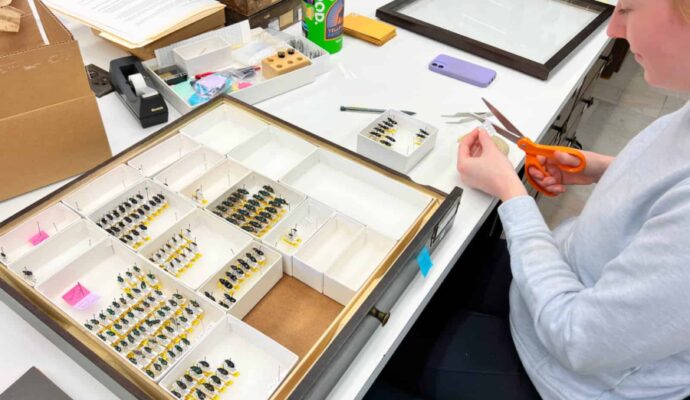
Another reason why I’ve always loved looking at the museum’s insects is compliments of the pin boards that have flanked its hallways. Showcasing perfect specimens from beetles to moths and butterflies, the subtle differences of each within its own species is simply beautiful.
So, why pin an insect? The pin not only acts as a handle for up close viewing, it also holds the teeny identification label. Additionally, it allows the legs to be viewed easily as they may be tucked under.
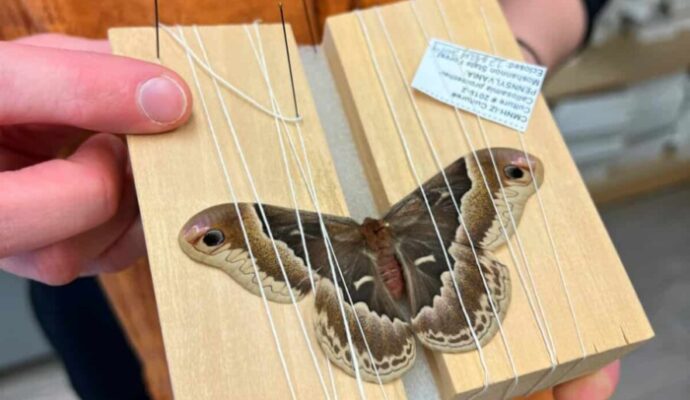
In the case of moths and butterflies, each needs to be pinned to see the color pattern on the wings, as well as the front and back legs. But what makes this entomology department unique in its pinning craft is that it it’s the only museum to pin them using strings.
The Silence of the Lambs and Carnegie Museum of Natural History Entomology
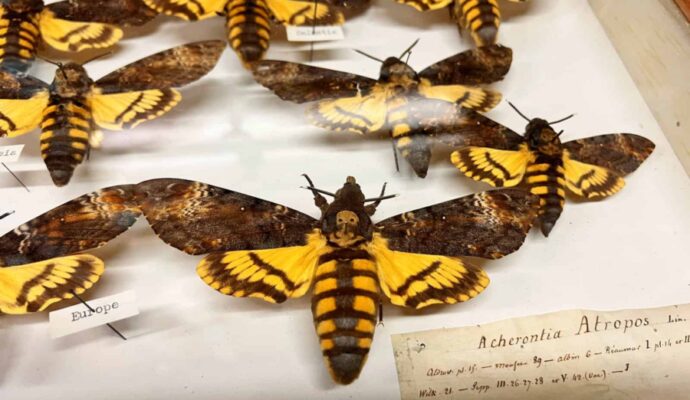
To the lay person, when watching the movie “The Silence of the Lambs” and seeing the gorgeous death’s head moths that were flittering around Buffalo Bill’s basement, you probably weren’t thinking, “Gee, I wonder how many different species there are?” but instead hoping you never have to hear “Goodbye Horses” from Q Lazzarus ever again.
So to quell your curiosity, I learned there are actually three different species of Death’s Head moths, each used in the movie:
Acherontia atropos: the African death’s-head hawkmoth used on the posters and video/DVD covers
Acherontia styx: the lesser death’s-head hawkmoth and the one mentioned by scientists in the movie
Acherontia lachesis,: the greater death’s-head hawkmoth
Fun fact: for the chrysalis in “The Silence of the Lambs”, additional goo was pumped into it so, when cut open, it would look creepier.
Side note: if you dig “The Silence of the Lambs” as much as I do, you can actually stay in Buffalo Bill’s house in the Laurel Highlands. It’s been turned into a B&B and can be rented per night. Although the basement scenes weren’t filmed there, it has been recreated, complete with well, basket, and toy dog.
